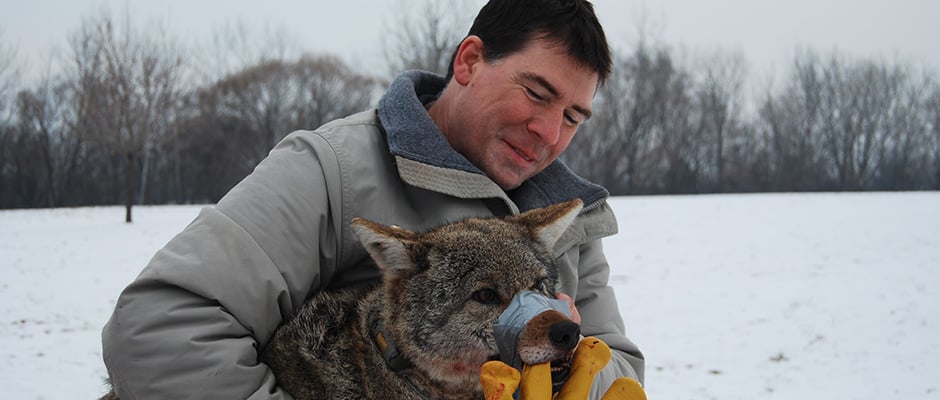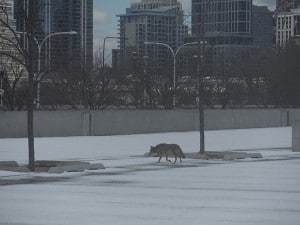Share this article
TWS Researchers Track Metropolitan Coyote Habits
Like many young people, she had to find ways to adapt to modern times. She grew up around the Schaumburg, Ill. suburb near the Chicago O’Hare International Airport in the 1990s, working long hours often into the night and often moving from home to home. As she got older, she decided to move near downtown Chicago where it was harder to make a living and competition was fiercer, but she proved to be ahead of the pack: an alpha female, if you will. She had a strong and independent survival instinct, but she stayed with the same mate for most of her life.
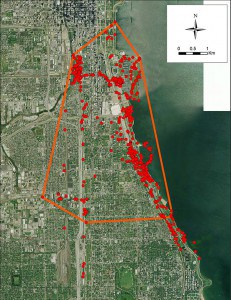
This map depicts GPS locations of an adult male coyote monitored during summer 2014. It is a downtown animal that used Lakeshore Drive, going up to the Field Museum and Soldier Field, and passing under the shadow of Sears Tower.
Image Credit: Stanley Gehrt
“They were an amazing couple,” said Stanley Gehrt, an associate professor of wildlife at the Ohio State University and a Wildlife Society member. Gehrt knew them both for most of their life after meeting the female one day in the park 15 years ago and can contest that despite a sometimes shaky reputation passed down from some of her ancestors, he never observed her to cause any kind of serious conflict with people.
Thirteen years after Gehrt had first captured her and attached a radio collar to track her movements through urban areas and with a little whiter hair, “the Schaumburg female” died of natural causes — not an easy achievement since coyotes living in urban areas often meet their end from cars or other vehicles.
She was the first coyote that Gehrt trapped in 2000 as part of what was then supposed to be a short project looking at the relatively new development of coyotes moving into cities.
“We initially caught her in this large, natural park, which is where we thought was the only place they could live,” he said. But the day after she was tagged and released, the Schaumburg female took Gerhrt on a wild goose chase through very urban areas. “In one night, I immediately realized that the coyotes were not restricted to these natural habitats,” he said. “These animals were living a lot closer to people than we realized.”
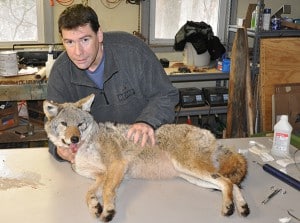
Researcher and TWS member Stanley Gehrt with the Schaumburg female coyote in 2011. The researchers tracked this coyote and others for the past 15 years to see the ways they adapted to urban settings.
Image Credit: Stanley Gehrt
Gerhrt tracked that coyote, her loyal, lifelong mate nicknamed “Melon Head” by the researchers and many others down through several generations with the use of GPS and radio collars over the next 15 years.
“We have multiple generations of coyotes that have been born and raised near people,” he said. “Our earliest ones are old geezers now.” They found some of the things that coyotes ate using scat analysis and the ways in which they marked territory in the suburbs. But the principle reason for the research was to watch the way the growing population interacted with humans and pets and to see whether the coyotes would lose their fear of people.
“The stakes are getting higher and higher as far as conflict, but so far we haven’t noticed any increase in conflict,” Gehrt said. “The fact that they’ve been able to move into every metropolitan area across North America is one of the most fascinating wildlife stories underway right now.”
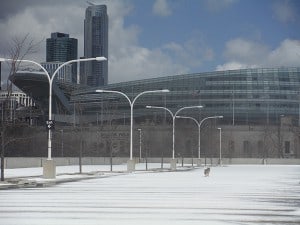
Coyote 748 — named for being the 748th coyote captured by researcher Stanley Gehrt — on the top of a parking garage in downtown Chicago with the Soldier Field football stadium behind.
Image Credit: Stanley Gehrt
More recently he’s been involved with studies making use of so-called Crittercams provided by National Geographic, as seen on a recent news feature on NBC Nightly News, to get a coyote-eye view of what they do from day to day. Using these technologies, Gehrt said they have found that in heavy urban areas like downtown Chicago, the animals are picky about crossing roads and sometimes do so in pairs. They also avoid eating dead opossums, which apparently don’t cater to the coyote palate, but will spend an hour pulling the feathers off dead songbirds before digging in. and sleep in small bushes or on top of carparks often right under the noses of human city-dwellers. However, Gehrt hasn’t seen footage of coyotes attacking domestic pets — an observation that correlates well with the more traditional data his team has gathered.
“You can’t have preconceived notions of what makes suitable habitat for these animals,” he said. “We didn’t think that coyotes would be able to penetrate or colonize certain parts of the Chicago area because it would just be too urban, but apparently there’s no part that they can’t colonize.”
He’s also trying to tell how the downtown dwellers mark their territory as they don’t tend to howl or leave scat the way suburban coyotes do. In another project, the team is studying coyote genetics to see if individual personality types such as boldness or shyness are better suited for close living with humans from the coyotes’ point of view.
“This is a great unplanned experiment that was started by the coyotes, so we don’t know when the end of the experiment is going to come,” Gehrt said of the animals moving into urban areas. “We don’t know what the final outcome is going to be with these animals living completely immersed among people.”
But one thing is certain for now — the Schaumburg female has left a huge legacy behind her. She was prodigiously fertile, having 60-70 offspring, according to Gehrt. Many of them moved into suburbs not too far from where they were born and one male even inherited a portion of her former territory.
“They learned to live in that landscape pretty well,” he said. Perhaps it is all in the genes.
Header Image:
TWS member Stanley Gehrt with a female coyote recaptured in in 2011. The animal was originally captured in Schaumburg, Ill., and the first urban coyote Gehrt captured when the project started 15 years ago. Now 12 years older, the coyote showed signs of aging.
Image Credit: Stanley Gehrt



